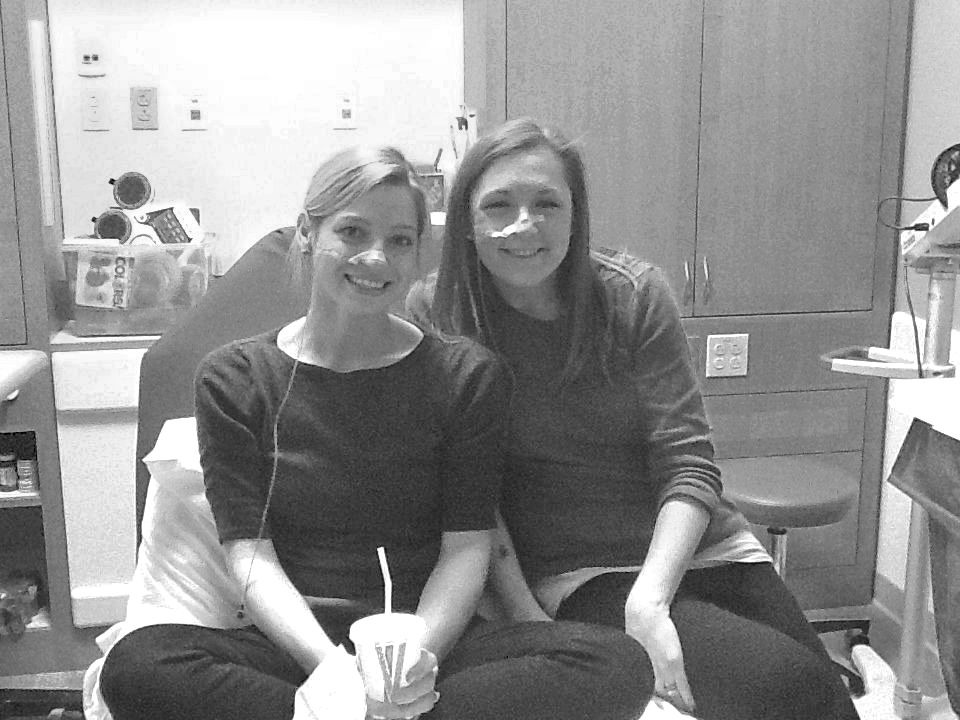How Parents Can Support Their Child Getting a Nasogastric (NG) Tube Placed
A nasogastric tube is a thin, flexible tube that enters the body through the nose and is passed down the throat until it reaches the stomach. This tube is used to provide food or medicine directly into the stomach, or it can be used to remove fluid that shouldn’t be there. People often call it a “NG tube” for short.
Demonstrating flexibility of a nasogastric tube ("NG tube).
I’ve provided play, preparation, and procedural support for dozens of children and teenagers requiring a nasogastric tube (“NG tube”) to be placed without general anesthesia/sedation. And well, the truth is it is invasive. Having a tube, or anything else entering the nose, is likely not the norm for your child. Heck, I get it. My colleague and I voluntarily had a NG placed to allow a new RN on the unit practice.
In 2013, child life specialists, Dawn Klausmeier and Megan Massey, volunteer to have NG tubes placed to give a new RN on the unit practice and to gain first hand experience as to what the procedure feels like.
But back to you, here you are. Your child either needs one for nutrition or for a procedure to diagnose or treat her condition. Getting the tube placed under general anesthesia isn’t always an option. So, what can you do as the parent or caregiver? Below are several tips to empower you, the parent or caregiver, with helping your child cope with getting a NG tube placed. There are many ideas below. Focus on a few that you know you can do. It’s tough being a parent with an ill or injured child who needs a NG tube, but got this!
Before the NG placement -
If your child is young or older with a history of anxiety, use honest and minimal language. Avoiding informing your child altogether can cause major distrust between you and your child or your child and the medical team. We’ve often seen this resulting in further stress, less application of coping strategies, or lack of cooperation.
Request a child life specialist or nurse to prepare your child to help them understand and cope. Using available resources can lessen the weight on you, so you can focus on taking care of you and your child. You are your child’s expert and they are the experts in what to expect for this procedure and how it’s done at their organization.
Ask/highlight/clarify with the medical educator out loud in front of your child what has “helped other kids/teens cope during this procedure.” Let this be a focal point. We know from a child development standpoint that kids and teens value what their peers think. Knowing this, I have found that kids and teens seem to appreciate knowing that other people their age have gone through this exact procedure and what those peers said helped them.
If it was not said, reiterate that “everyone feels things differently. You will have to tell us afterwards how it felt for you.” Having uncle John talk about how awful it felt is not helpful. The truth is it does feel somewhat different for everyone. For some using coping strategies, like imagery, counting or drinking water, the experience can be less “uncomfortable” or “annoying.”
Advocate for what you feel will help your child cope best. This could be an oral or nasal medicine to help calm them or take away sensation in the nose (not always an option), less staff in room, comfort positioning, use of the treatment room, or choice of which side of the nose the NG tube is placed.
Help them pick out an activity in the playroom they can do afterwards in bed. Remind them they can still P L A Y with a NG tube in.
What you can do to help your child during a Nasogastric Tube placement at the time of the procedure
It’s difficult to see your child in any kind of pain, anxiety or exhibiting other negative emotions. Still, remaining calm yourself will help model positive coping and allow opportunity for you to play an active role in supporting your child.
Tell the staff some things about your child! This can help build a relationship and use conversation as a distraction make the environment more relaxing.
Know that it’s okay if you feel it is not best for the situation or your child if you are present at the time of the procedure. You can designate another trusted caregiver to support your child, if available. If not, that’s okay too. Like I said, I’ve worked with many different families. Sometimes the child is given the best support and guidance from the staff and the parent is then able to be “the hero” afterwards and comes in to provide that loving touch and support when the NG tube is in.
If you are present, here are some other things you can do to help:
o Hold child’s hand
o Talk with the team beforehand to see if you can hold/guide a cup of ice water with straw to help child assist tube into body via swallowing
o Discuss with child and team who will be providing encouraging words – choose 1 person to speak at a time. If the nurse is explaining steps, pause so not too many voices are yelling at once. This can get chaotic and overwhelming for the child/teen and rest of the persons in the room.
Helping a child to stay calm right before and after the NG tube is placed is key. Most children will react to this procedure – this is normal. Some may tear up, cough/gag, or physically resist. Staff are trained to make sure your child is safe. You may hold a child in your lap in a comfort hold, but this is not necessary if you feel it is requiring to help hold your child. Let the staff do this carefully and safely.
Keep in mind that when a child is demonstrating a high level of anxiety, rationalizing with them will not be effective in calming them. Distraction is the best way.
o Where is your favorite place to go with your family?
o Tell me about your favorite toy to play with.
o If you could have one superpower, what would it be?
o Would you rather smell like a fish or have to eat with chopsticks your whole life?
Sometimes highly anxious children will say they cannot breathe. Remind them that if they are talking, they are breathing.
Focus on positives, even if the child or teen is having a difficult time coping or cooperating. Praise them for using coping strategies like closing their eyes or being cooperative by taking sips of water.
It’s okay if you need to step out of the room.
After the NG tube is placed –
Redirect your child to focus on doing an activity to take their mind off of the new sensation of the tube in their body.
Remind the child that other kids and teens have said “your body gets used to it and it feels less uncomfortable when you aren’t focused on it.” For any age, but especially if your child is younger, the best thing is to get them doing an activity. I like providing them a choice of a special painting or clay activity they can do right in their bed.
Talk with the nurse about other remedies for discomfort, such as numbing spray for the throat, drinking water or eating a popsicle.
Take care of yourself. Having a child or teen who needs a NG tube placed is very challenging. Allow another supportive adult give you a break, so you can take a walk or even leave the hospital.
Many also find it helpful to have the tube secured to the back of their gown. This allows for more freedom in movement, and for younger children, may make it less likely to be pulled out. Ask the medical team for help with this.
Kids and teens sometimes express concern about how the tube will feel getting removed.
Getting the NG tube removed -
Many find the adhesive removers are very helpful in easily removing the tegaderm or tape used to secure the tube to the cheek or nose.
You can talk to the nurse about offering your child the choice to help with this part. This helps many kids and teens feel less anxious and more in control.
Most kids and teens have described it as “weird.” You can say it "slips out quickly like a spaghetti noodle."
I’d say almost all kids are surprised by how quick and easy the tube comes out.
Here are some resources to help prepare and support you and your child/teen for a NG tube placement:
Preparation video:
“Getting a Nasogastric (NG) Tube placed at Children’s Hospital of Wisconsin”
Note: Some comments below the video are personal and unique to that individual’s experience. Please use this blog post as a guidance of what to expect and how to help your child cope.
“Healing Images for Children: Teaching Relaxation and Guided Imagery to Children Facing Cancer and other Serious Illnesses” by Nancy Klein. Available on Amazon.
Note: If you are aware of the need for the NG tube placement ahead of time, encourage your child/teen to practice relaxation techniques prior to hospitalization. More practice using them may help build their confidence in utilizing them when they are in an unfamiliar or stressful environment, like at the hospital.



